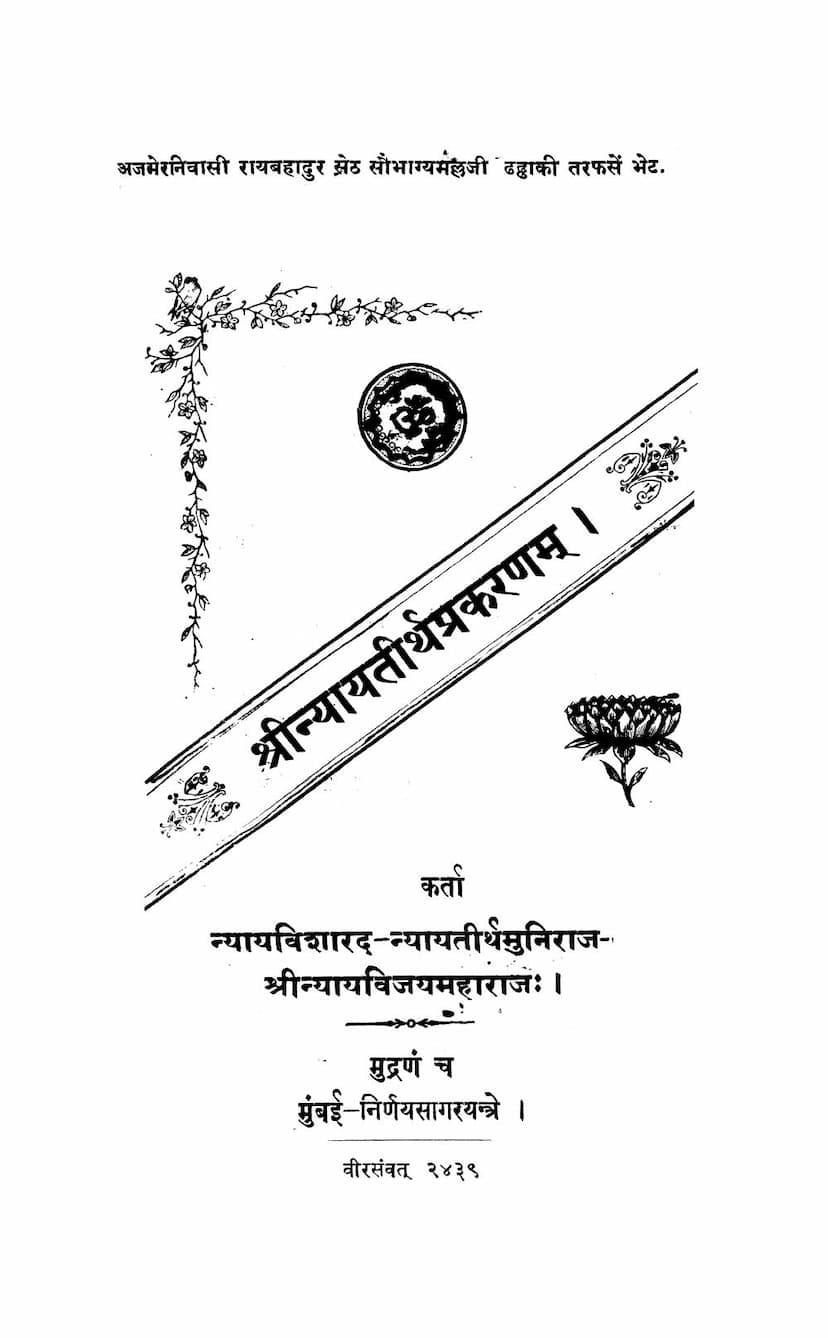Nyaya Tirth Prakaranam
Added to library: September 2, 2025

Summary
This is a comprehensive summary of the Jain text "Nyaya Tirth Prakaranam" by Nyayvijay, published by Nirnaysagar Press. The text is dedicated to Shri Vijaydharm Suri and was printed in Veer Samvat 2439 (1913 AD).
Key Aspects of the Text:
The book "Nyaya Tirth Prakaranam" is a systematic treatise on Jain logic (Nyaya) designed for beginners, aiming to provide them with an introduction to the core concepts of Jain philosophy and epistemology. The author, Nyayvijay, states that he has reorganized and expanded upon previous works on Jain logic, including the "Praman Paribhasha Sutras" and its commentaries, due to the complexity of those texts for new learners.
The work is structured into seven chapters (Sopana), each covering a specific aspect of Jain logic:
- Praman (Source of Knowledge) - General Nature, Subject Matter, and Results: This chapter introduces the fundamental concept of Praman, its general characteristics, the objects it cognizes, and its ultimate purpose. It emphasizes the correct use of the word "Samyak" (right) in "Samyak Gyan" (right knowledge) to distinguish valid knowledge from doubt, error, and indeterminate knowledge. It also discusses the difference between valid and invalid knowledge (praman and apraman) and their origin (self or external factors).
- Praman - Direct and Indirect Knowledge (Pratyaksha and Paroksha): This chapter delves into the two primary types of Praman: Pratyaksha (direct perception) and Paroksha (indirect knowledge).
- Pratyaksha is further classified into:
- Paramarthika Pratyaksha (Absolute Direct Perception): This includes Avadhi Gyan (clairvoyance) and Manahparyaya Gyan (telepathy), which are considered "vikal" (incomplete) due to their limited scope. Keval Gyan (omniscience) is the "sakala" (complete) form of Paramarthika Pratyaksha, achieved through the destruction of karmic coverings. The text discusses the nature of omniscience, its attainment, and the attributes of the omniscient being (Arhant).
- Samvyavaharika Pratyaksha (Conventional Direct Perception): This is the knowledge gained through the senses and the mind. It is further categorized into knowledge gained through the senses (Indriya) and the mind (Anindriya). The text details the five senses and the mind, their objects, and the debate on whether the senses (especially the eyes and ears) are "praptakari" (requiring contact) or "apraptakari" (cognizing without contact). It argues for the "praptakari" nature of senses, including the ear, based on various arguments and scriptural references.
- Paroksha is then elaborated upon in the subsequent chapter.
- Pratyaksha is further classified into:
- Praman - Types of Indirect Knowledge (Smriti, Pratyabhijna, Tarka, Anumana, Agama): This chapter discusses the various forms of indirect knowledge:
- Smriti (Memory): Knowledge of past experiences.
- Pratyabhijna (Recognition): The knowledge that identifies something as the same as previously perceived, often involving a combination of past and present elements.
- Tarka (Reasoning/Hypothetical Reasoning): The process of understanding the relationship between a cause and its effect or a sign and its signified, particularly the concept of "vyapti" (invariable concomitance).
- Anumana (Inference): Knowledge derived from a middle term (hetu) that leads to the knowledge of the conclusion (sadhy). It's divided into "Swartha" (for oneself) and "Parartha" (for others). The text analyzes the structure of inference and critiques various theories of reasoning.
- Agama (Scriptural Testimony/Authority): Knowledge derived from the words of an infallible authority (Apta). This chapter also introduces the concept of Saptabhangi (the doctrine of sevenfold predication) as a characteristic of Agama, explaining how it allows for multiple, seemingly contradictory, assertions about reality.
- Praman - Fallacies (Abhasa): This chapter deals with "Apraman" or "Pramana Abhasa" – sources of knowledge that appear to be valid but are actually erroneous or fallacious. It explains that these are either lacking the characteristics of true Praman or merely resemble them. It discusses various types of fallacies, including those related to doubt, error, indeterminate knowledge, and specific fallacies in inference (Paksha-abhasa, Hetu-abhasa, etc.), as well as fallacies in scriptural interpretation.
- Naya (Standpoints/Methods of Knowing): This chapter introduces the concept of "Naya," which are different perspectives or standpoints from which reality can be understood. It explains that these are partial cognitions of the multifaceted nature of reality and are not entirely separate from Praman, nor are they entirely non-Praman.
- The Nayas are broadly categorized into Dravyarthika Naya (viewpoint focused on substance/essence) and Paryayarthika Naya (viewpoint focused on modes/attributes).
- Dravyarthika Naya is further divided into:
- Naigama: Considers both substance and its modes.
- Sangraha: Focuses on the general category or universal.
- Vyavahara: Deals with the practical, conventional classifications.
- Paryayarthika Naya is further divided into:
- Rijusutra: Focuses on the present moment and immediate modifications.
- Shabda: Analyzes the meaning derived from words, considering different grammatical aspects.
- Samabhirudha: Focuses on the etymological meaning of words.
- Evambhuta: Considers the meaning of a word only when the action or attribute it denotes is actually present.
- The chapter also discusses the "Abhasa" or fallacious aspects of these Nayas.
- Vada (Debate/Discussion): This final chapter outlines the principles and conduct of a philosophical debate. It defines Vada and distinguishes it from Japa (mere talk) and Vitanda (destructive argumentation). It details the participants in a debate (Vadī - speaker, Prativadī - opponent, Sabhya - assessors, Sabhapati - chairman), their qualifications, and the stages of a debate. The text emphasizes that the aim of Vada is to ascertain truth through reasoned argument and to refute incorrect viewpoints.
Overall Purpose and Significance:
"Nyaya Tirth Prakaranam" serves as a foundational text for understanding the complex philosophical and logical framework of Jainism. By systematically explaining the concept of Praman, its types, and its fallacies, along with the nuances of Naya and the proper conduct of debate, the book equips students with the tools necessary to engage with Jain philosophical literature and to understand the Jain worldview. The author's intention is to make these profound philosophical concepts accessible to a wider audience, particularly those new to the subject.